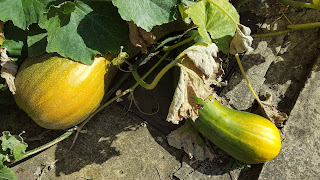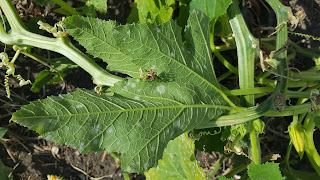The corn is now brown and old. My courgettes have produced one last, huge courgette, but stopped flowering, so there will be no more there. The cucurbits (squashes and courgettes) are also uniformly covered in a dusting of powdery mildew and many patches are bare where I removed leaves to try and prevent the mildew from spreading. Interestingly, the only places the cucurbits aren't consumed in mildew are where the plants have crept into and up my bean stalks. I'm not sure if there's something protective about the beans or if it's being off the ground they like. I will try to remember to give them supports next year so they can lift themselves off the ground.
My purple beans also fell over in the winds of the storms while we were away, and my sunflowers lost a number of stalks and seed heads to the storms.
However, all was not lost. Despite having toppled to the side, the purple bean plants are still producing plenty of beans. My squashes are finally turning from deep green to ripe orange.
It is the season for harvesting, so there is plenty to eat in the garden yet. Last night, having finally finished off the latest crop of beans I was wondering what except chard (which I like much more to look at than to eat), I could possibly eat with my dinner. It was then that I had an aha moment. All those things I'd been ignoring all summer because they were too small were finally ready to harvest. So I pulled out two beetroot and two carrots.
I peeled and quartered the beetroots and roasted them along with my potatoes. Finally, I selected the smaller, fresher beetroot leaves and cooked them just like I cook chard. I cut out the stalks and chopped them into 3 cm lengths, then roughly chopped the remaining leaves. The stalks I boiled for 6 minutes (in with the carrots for the last 6 minutes of their cooking time) and the chopped beetroot leaves I boiled for 3 minutes (also in with the carrots). They turned the water a bit red, but seem not to have had any impact on the colour of the carrots themselves. In case you're wondering, the meat is roast gammon and I made a cider gravy to go with it.
Cider gravy recipe (serves 4 with a thick gravy, 6 or 8 with a thinner gravy):
1 tbsp butter
1 tbsp cornflour (=cornstarch in US English)
1 small bottle of (optionally low/no alcohol) cider
Optionally some of the juice that has collected in the pan from any meat you are roasting
1. Melt the butter in a pan over a low heat.
2. Add the cornflour and stir to form a paste.
3. Gradually add the cider about 1-2 tbsp at a time. Keep stirring until the gravy is smooth each time before you add any more. Keep adding cider until you have a consistency you like. Once you have reached a consistency you like, turn up the heat and keep stirring until the gravy bubbles. Once it has bubbled, check whether you still like the consistency. If it's too thick now, add more cider as before.
4. Optionally add 1-2 tbsp of the juices from any meat you were roasting and stir in.















